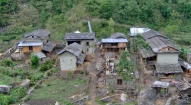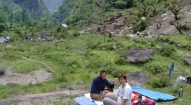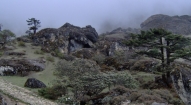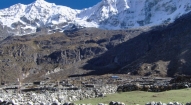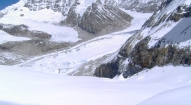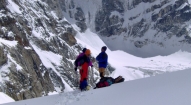- Home |
- Why With Us |
- About Us |
- Booking |
- Contact Us |
- Site Map
- Home
-
Nepal
-
Trekking
- Arun Valley with Gokyo Lakes
- Everest Base Camp Trek
- Everest- A Living Culture Exploration
- Everest Explore
- Everest Base Camp (via Thame) Trek
- Everest Base Camp with Kala Patthar
- Everest Comfort Trek
- Everest High Passes with Ama Dablam Base Camp
- Everest Mani Rimdu Festival Trek
- Everest Nagpa La Trek
- Everest with three high passes
- Gokyo Ri, Chola Pass & Chukung Ri with Kala Patthar
- Gokyo with Everest Base Camp
- Jomsom - Muktinath
- Jomsom - Muktinath
- Khayar Lake Trek
- Manaslu and Tsum Valley with Larkya La
- Upper Mustang Trek
- Manaslu High Circuit
- Manaslu, Tilicho Pass & Upper Mustang
- Annapurna Base Camp Trek
- The Annapurna Circuit Trek
- Annapurna Panorama
- Nar and Phu Valley Trekking
- Nepal Rhododendron Trek
- Royal Trek
- Saribung Trek and Expedition
- Annapurna Sanctuary Trek
- The Annapurna Sunrise Trek
- Expedition
-
Rafting
-
Peak Climbing
-
Tours
- Kathmandu-Chitwan-Jungle Tour with visit to Pokhara
- Dawn to Dusk Tour
- Historical, Natural & Cultural Tour with Camping
- Kathmandu Valley Temple Tour
- Temple - Panorama - Jungle Tour
- Taste of Nepal
- Central Nepal Tour
- Explore Nepal Tour & Trek
- Nepal Cross-country Tour
- Best of Nepal Tour & Treks
- Kathmandu valley rim Tour & Treks
- Nepal Culture Tour
- Introduction to Nepal Tour & Treks
- Nepal at a glance Tour & Treks
- Wonders of Nepal Tour & Treks
- Glimpses of Nepal Tour & Treks
- Through the Silhouette Tour & Treks
- Tent and Temple Tour
- Kathmandu-Chitwan-Pokhara Tour
- Historical, Cultural City and Jungle Tour
- Nepal Wildlife Tour
- Nepal Panorama Historical Tour
- Nepal Adventure Tour
- Nepal Pilgrimage Tour
- Ghalegaun-Ghanapokhara Homestay Tour
- Jungle Safari
- Adventure Sports
-
Trekking
- Tibet
-
Bhutan
-
India
- Yoga Tour
- About Us
-
The Great Himalayan Trail
-
Short Tours/Treks


Rolwaling trek via Tashi Labsta to Lukla
Days from
If you have ever tried to call home from Kathmandu, and tried to work out the time of day in your home country, you may well have become befuddled and confused by the timezone in Nepal which is GMT +5.45 (or is it GHT +4.45). Most other countries are on the hour or half hour which is slightly easier to calculate (incidentally this useful tool might help). The answer to why lies on this trek, or specifically, Nepal’s time-zone is set according to the sunrise on Gauri Shankar, the holy mountain that is prominent in the region.
| Max. Elevation : | Grade : |
| Best season : | Type of trek : |
| Duration : | Starting point : |
| Ending point : | Highlights : |
If you have ever tried to call home from Kathmandu, and tried to work out the time of day in your home country, you may well have become befuddled and confused by the timezone in Nepal which is GMT +5.45 (or is it GHT +4.45). Most other countries are on the hour or half hour which is slightly easier to calculate (incidentally this useful tool might help). The answer to why lies on this trek, or specifically, Nepal’s time-zone is set according to the sunrise on Gauri Shankar, the holy mountain that is prominent in the region.
Watching sunrise on Gauri Shankar could be one special moment on this trek:
“From this camp [at Na Gaon] the sunrise (September to November) over Gauri Shankar is one of the great visual images, as the sun’s rays touch the far peak of Gauri Shankar turning it into a golden crown, while the rest of the mountain is still in its night-time colours of silver grey,” says Les of artphototravel.net.
The trek is diverse in terms of cultures you’ll meet and landscapes. The area is populated by Buddhist Tamang, Sherpa and Gurung communities and you can visit their functioning monasteries along the way. From low, agricultural landscapes, to high mountain scenery, the trek gives you a fabulous slice of Himalayan geography. Finally you get the excitement of crossing over and descending into new valley, with all the satisfaction taking the less easy way brings.
According to the guidebook mentioned below, most visitors to this area who were surveyed in 2003 by Eco Himal, an Austrian NGO, said they visited mainly because it was ‘untouched’ or ‘unspoilt’, and wanting to escape the ‘touristyness’ and ‘overcrowding’ of the three main trekking areas.
This section of the GHT can best be started at The Last Resort, as this gives you much better acclimatization and a chance to develop your trekking legs. You can come from the Everest side, but take an extra day to acclimatize properly in Thame if you do.
Crossing the Tashi Labsta
This is not to be taken lightly. It’s certainly crossable, but precautions need to be taken. Not only is it high at 5,760m, but is glaciated and prone to rockfall. You’ll need ropes, harnesses, crampons and ice-axes and preferably know how to use them all. Most important of all, you’ll have a guide who knows the most recent route. Glacial areas are constantly shifting, and the route can be different season by season.
Trekking time
Les recommends suggested trekking time is 25 days (minimum) composed of 5 days Dolkata to Beding, 2 -3 days Beding and Na Gaon, 5 days up to the high camp near Ramdung base camp exploring and acclimatizing, 4 days to the Tashi Lapsta pass, 4 days exploring, at the pass and climbing Parchamo, 3 days to Namche bazaar, 2 days to Lukla.
For further information and itinerary please contact us
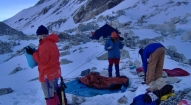
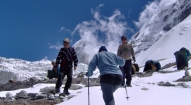
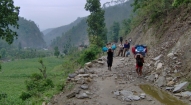
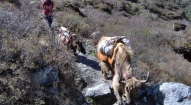
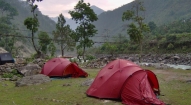
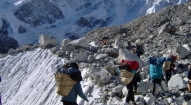



Trekking in Nepal
Expeditions In Nepal
Rafting in Nepal
Tours in Nepal
All rights reserved.



